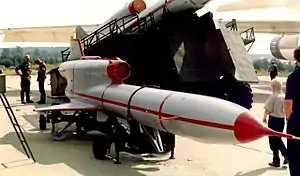Tupolev Tu-143
The Tupolev Tu-143 Reys (Flight or Trip, Russian: Рейс; also Reis, Rejs) was a Soviet unmanned reconnaissance aircraft in service with the Soviet Army and a number of its Warsaw Pact and Middle East allies during the late 1970s and 1980s. It contained a reconnaissance pod that was retrieved after flight, and from which imagery was retrieved.[1]
| Tu-143 | |
|---|---|
 | |
| Tu-143 "Reys" | |
| Role | unmanned reconnaissance aircraft |
| Manufacturer | Tupolev |
| First flight | 1970 (Tu-243 1987) |
| Introduction | 1976 (Army i.e. Ground Forces, SSV) 1982 (Air Force, VVS) (Tu-243 1999) |
| Status | Active |
| Primary user | Soviet Union Russia Ukraine |
| Produced | 1973–1989 (Tu-243 1994-) |
| Number built | 950 |
| Developed from | Tupolev Tu-141 |
History
Development

The Tu-143 was introduced in 1976 and strongly resembled the Tu-141, but was substantially scaled-down. It was a short-range (60–70 kilometer) tactical reconnaissance system and had low-level flight capability. The Tu-143 was truck-launched with JATO boosting, recovered by parachute, and powered by a TR3-117 turbojet with 5.8 kN (590 kgf, 1300 lbf) thrust. The initial version carried film cameras, but later versions carried a TV or radiation detection payload, with data relayed to a ground station over a datalink. Some 950 units were produced in the 1970s and 1980s.
Operation history
The Tu-143 was used by Syria in reconnaissance missions over Israel and Lebanon during the 1982 Lebanon War, as well as by Soviet forces in Afghanistan during the Soviet–Afghan War.
During the 2022 Russian invasion of Ukraine, Ukraine appeared to use them to spot Russian air defences and as an ersatz cruise missile. [2] On 29 June 2022, one Tu-143 carrying explosives was shot down in Kursk Oblast. [3]
M-143 variant
A target drone version, the M-143, was introduced in the mid-1980s.
Tu-243 variant
The Tu-143 was followed into service in the late 1990s by the similar but improved "Tu-243 Reys-D", with a 25 cm (10 inch) fuselage stretch, to provide greater fuel capacity and about twice the range; it had an uprated TR3-117 engine with 6.28 kN (640 kgf, 1,410 lbf) thrust; and improved low-altitude guidance.[4]
Tu-300 variant
Since 1995, Tupolev began promoting the further refined "Tu-300 Korshun", which resembles its predecessors but is fitted with a nose antenna dome and nose fairings for modern sensors and electronic systems. It also features a centerline pylon for a sensor pod or munitions. Financial issues forced a halt to development at the end of the 1990s, but work was resumed in 2007.
Operators
Current operators
Former operators
.svg.png.webp) Republic of Belarus
Republic of Belarus.svg.png.webp) People's Republic of Bulgaria /
People's Republic of Bulgaria /  Bulgaria
Bulgaria- retired
 Czech Republic
Czech Republic- VR-3 Rejs, retired in 1995
 Czechoslovakia
Czechoslovakia- VR-3 was in service from 1985, passed to Czech Republic and Slovakia
.svg.png.webp) Ba'athist Iraq /
Ba'athist Iraq / .svg.png.webp) Republic of Iraq /
Republic of Iraq /  Iraq
Iraq.svg.png.webp) Socialist Republic of Romania /
Socialist Republic of Romania /  Romania
Romania- VR-3 in service from 1987 until the early 2000s[7]
 Slovakia
Slovakia- VR-3 Rejs, retired
 Soviet Union
Soviet Union- Passed to Russia and Ukraine on dissolution of the USSR
Specifications
Tupolev TU-143 Reys:
- wingspan 2.24 m (7 ft 4 in)
- length 8.06 m (26 ft 5 in)
- height 1.54 m (5 ft 1 in)
- launch weight 1,230 kg (2,710 lb)
- maximum speed 950 km/h (515 kn, 590 mph)
- engine Klimov turbojet TR3-117
- service ceiling 5,000 m (16,400 ft)
- range 200 km (110 nmi, 125 mi)
References
This article contains material that originally came from the web article Unmanned Aerial Vehicles by Greg Goebel, which exists in the Public Domain.
- The Encyclopedia of the Arab-Israeli Conflict: A Political, Social, and Military History: A Political, Social, and Military History, ABC-CLIO, 12 May 2008, by Spencer C. Tucker, Priscilla Mary Roberts, page 1055
- "Cheering Its Own Misery – Why Did Ukraine 'Celebrate' Downing Of Its Own Tupolev Tu-143 Drone By Russia?". April 18, 2022.
- "Cruise Missile or Suicide Drone – Russia Shoots Down Invading Tu-143 Inside Its Airspace With Buk Missile". July 1, 2022.
- "ВР-3 «Рейс», комплекс воздушной разведки с беспилотным летательным аппаратом Ту-143 — ОРУЖИЕ РОССИИ, Федеральный электронный справочник вооружения и военной техники". www.arms-expo.ru. Archived from the original on 24 October 2009. Retrieved 12 January 2022.
- "Воздушные мишени – вторая жизнь зенитных ракет — ОРУЖИЕ РОССИИ, Информационное агентство". Arms-expo.ru. Archived from the original on 2011-10-25. Retrieved 2013-09-03.
- The Military Balance 2016, p. 190.
- "VR-3 (TU-143)". Aripi Argintii (in Romanian). Archived from the original on 11 July 2017.
External links
- Czech Tu-143/VR-3 Rejs in museum with transport vehicle and launcher